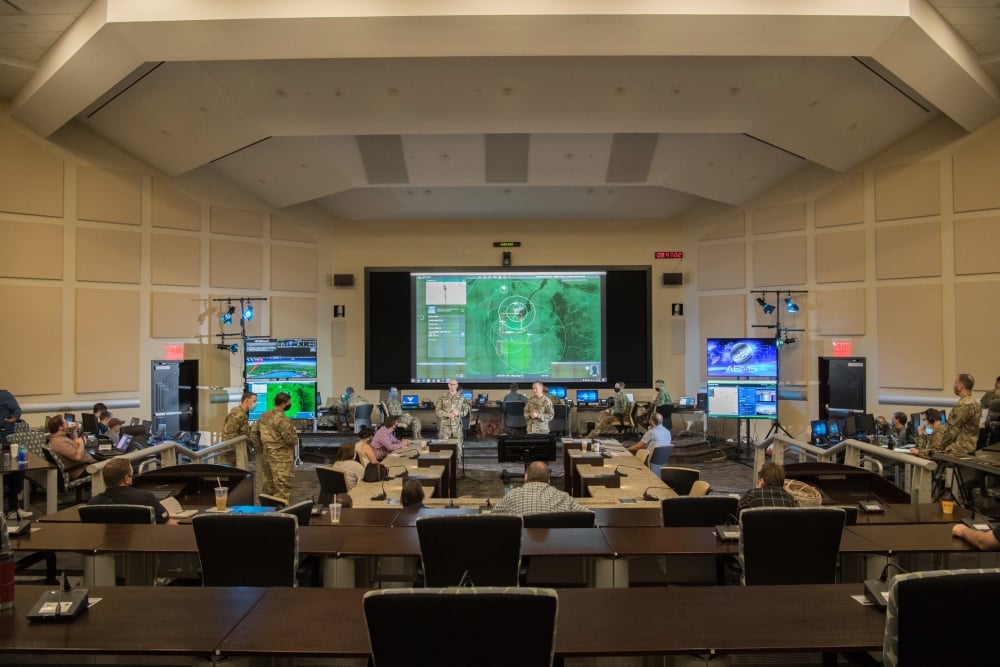 WASHINGTON: The Air Force has overhauled the Advanced Battle Management System program to better integrate it into the service’s traditional acquisition structure — and will field the first ABMS gear next year.
WASHINGTON: The Air Force has overhauled the Advanced Battle Management System program to better integrate it into the service’s traditional acquisition structure — and will field the first ABMS gear next year.
The changes were made to move the program away from its past focus on rapid tech experimentation and development to a more traditional emphasis on fielding operational capabilities, one Air Force official explained.
The first “package” of ABMS capabilities to be fielded will be a new pod-based communications system for the KC-46, enabling the tanker to serve as a kind of flying cell tower between the incompatible radio systems of the F-22 and F-35 fighters. That system will be fielded sometime in the last quarter of fiscal year 2022, according to an email from a service spokesperson.
The email was in response to questions put to the service almost two months ago, which we finally received Friday — simultaneously with the Air Force press release officially marking the ABMS “transition” to a full-fledged acquisition program.
Further, the service also has created a new Cross Functional Team (CFT), led by Brig. Gen. Jeffery Valenzia to establish ABMS “manpower, resources and doctrinal infrastructure,” the press release said. Valenzia, an Air Force official told us, sits on the service’s J5 plans and program staff and has been sitting on the Joint Staff’s CFT for development of the Joint All Domain Command and Control (JADC2) strategy. ABMS is being designed by the service to serve as its C2 underpinning for JADC2 — with the new strategy expected to be released by DoD by the end of next month.
The Air Force Rapid Capabilities Office (RCO), which was charged last year to take on ABMS as a program of record, also has jettisoned the Silicon Valley-esque construct and naming convention instituted by former service acquisition head Will Roper. So no more “on-ramp” demonstrations, no more “products,” no more cool new software/gadgets with the suffix ‘ONE.’
“ABMS has pivoted away from the identification of capabilities by their legacy ‘ONE” product monikers’,” the Air Force spokesperson wrote. Instead, RCO will “build ABMS as a secure, military digital network environment leveraging proven commercial technologies, infrastructure, and applications. The ABMS acquisition effort provides the materiel capabilities enabling the ABMS operational concepts.”
Nor will the RCO’s future “Capabilities Release” packages necessarily map the list of “products” — such as cloudONE or gatewayONE — the Air Force previously identified as part of ABMS.
“ABMS acquisition efforts will focus on investing in enduring digital infrastructure and delivering Capability Releases (CRs)-individual pieces or parts of the larger system being fielded in discrete iterations that won’t always align to the previous ‘product line’ construct,” the spokesperson said.
For the moment, the planned KC-46 pod is the only “Capabilities Release” package that has been “established,” the spokesperson added. Each package will require the joint approval of Air Force Chief of Staff Gen. CQ Brown and Chief of Space Operations Gen. Jay Raymond, the spokesperson said.
But RCO has developed a matrix of capabilities it intends to deliver under ABMS, the spokesperson wrote:
- Secure Processing: Provide hybrid commercial and edge multi-cloud environments and edge devices for secure processing, data management, and applications at all security levels.
- Connectivity: Provide agile communications, connectivity, and mesh networking between sensors, decision nodes, and mission effects to support mission execution, including under degraded conditions.
- Data Management: Provide a data architecture across the network for data across all domains and from multiple sensor types at multiple security levels so static and streaming data are properly characterized, available, and discoverable.
- Applications: Provide applications, leveraging artificial intelligence and machine learning, to enable data processing, data fusion, all-domain operating pictures, and machine-to-machine command and control.
- Sensor Integration: Integrate sensors into a network to enable publishing of real time and static data for joint all-domain missions.
- Effects Integration: Integrate kinetic and non-kinetic effects using machine-to-machine command and control.
The service spokesperson explained that RCO will use “a range” of contracting types, “tailored to the capability being delivered.” These include “Multiple Award ID/IQ, Broad Agency Announcements (BAAs), Other Transactions, Small Business Innovative Research (SIBR) Phase III, existing contracts, and Cooperative Research and Development Agreements (CRADAs),” the email stated.
Meanwhile, Preston Dunlap’s Chief Architect Office will continue to undertake ABMS-related experiments — now called “Architecture Demonstration and Evaluation (ADE) events,” according to the spokesperson. Dunlap’s office and RCO “will coordinate to ensure unity of effort and will work to integrate ABMS capabilities inclusion in future DAF Architecture Demonstration and Evaluation events,” the spokesperson wrote.
Whether those demonstrations continue on their earlier four-month cycle, however, is up in the air. Because of the massive chop Congress took out of the ABMS budget request for 2021, the Air Force could only undertake two of three planned demonstrations.
RCO also had to push back actual investment in the new KC-46 comms pod from this year until fiscal year 2022.
The service received $170 million for ABMS this fiscal year, and intends to keep spending on improvements over the next five years.






















